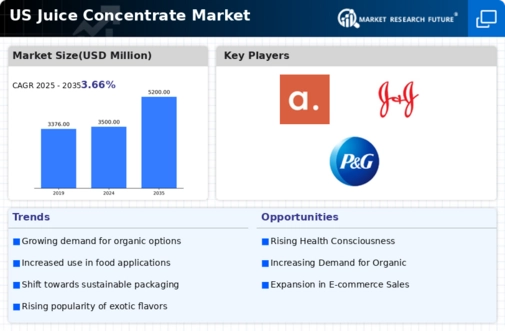Emerging Trends in Flavor Profiles
The juice concentrate market is evolving with the emergence of innovative flavor profiles that cater to diverse consumer tastes. As palates become more adventurous, there is a growing demand for unique and exotic flavors, such as acai, dragon fruit, and hibiscus. This trend is reflected in market data, which shows that sales of non-traditional juice concentrates have increased by 30% over the past year. The juice concentrate market industry is responding by experimenting with flavor combinations and introducing limited-edition products to attract consumers. This focus on flavor innovation not only enhances product appeal but also encourages brand loyalty among consumers seeking new taste experiences.
Sustainability and Ethical Sourcing
The juice concentrate market is increasingly influenced by sustainability and ethical sourcing practices. Consumers are becoming more aware of the environmental impact of their purchases, leading to a demand for products that are produced sustainably. This trend is evident as brands that emphasize eco-friendly practices and transparent sourcing have seen a rise in consumer trust and loyalty. The juice concentrate market industry is adapting by implementing sustainable farming practices and reducing carbon footprints in production processes. Market data suggests that products marketed as sustainably sourced have experienced a growth rate of 18% in sales. As sustainability continues to be a priority for consumers, the juice concentrate market is likely to see further shifts towards environmentally responsible practices.
Convenience and On-the-Go Consumption
The fast-paced lifestyle of consumers in the US is significantly influencing the juice concentrate market. There is a growing preference for convenient, ready-to-drink options that cater to on-the-go consumption. This trend is evident as sales of single-serve juice concentrate products have increased by 15% in the last year. The juice concentrate market industry is responding by innovating packaging solutions that enhance portability while maintaining product quality. Additionally, the rise of e-commerce platforms has facilitated easier access to these products, further driving their popularity. As consumers seek quick and nutritious beverage options, the demand for convenient juice concentrates is expected to continue its upward trajectory.
Rising Demand for Natural Ingredients
The juice concentrate market is experiencing a notable shift towards natural ingredients, driven by consumer preferences for clean label products. As health-conscious consumers increasingly scrutinize ingredient lists, manufacturers are compelled to offer juice concentrates that are free from artificial additives and preservatives. This trend is reflected in market data, indicating that the demand for organic juice concentrates has surged by approximately 25% over the past year. The juice concentrate market industry is adapting to this demand by sourcing high-quality, natural fruits, which not only enhances flavor but also aligns with the growing consumer inclination towards healthier options. Consequently, brands that prioritize natural ingredients are likely to gain a competitive edge in this evolving landscape.
Increased Focus on Functional Beverages
The juice concentrate market is witnessing a surge in interest towards functional beverages that offer health benefits beyond basic nutrition. Consumers are increasingly seeking products that provide added value, such as enhanced hydration, immunity support, and digestive health. This trend is supported by Market Research Future indicating that functional juice concentrates have seen a growth rate of approximately 20% in recent years. The juice concentrate market industry is capitalizing on this trend by developing products infused with vitamins, minerals, and probiotics. As consumers become more aware of the health benefits associated with these functional ingredients, the demand for such juice concentrates is likely to expand, creating new opportunities for manufacturers.














Leave a Comment